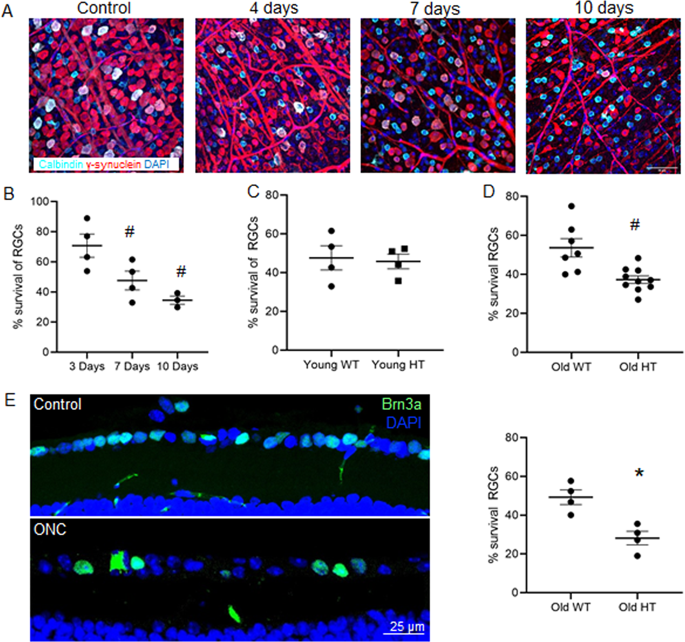当前位置:
X-MOL 学术
›
Cell Death Discov.
›
论文详情
Our official English website, www.x-mol.net, welcomes your
feedback! (Note: you will need to create a separate account there.)
Age related retinal Ganglion cell susceptibility in context of autophagy deficiency.
Cell Death Discovery ( IF 6.1 ) Pub Date : 2020-04-17 , DOI: 10.1038/s41420-020-0257-4 Katharina Bell 1, 2 , Ines Rosignol 1 , Elena Sierra-Filardi 1 , Natalia Rodriguez-Muela 1, 3 , Carsten Schmelter 2 , Francesco Cecconi 4 , Franz Grus 2 , Patricia Boya 1
Cell Death Discovery ( IF 6.1 ) Pub Date : 2020-04-17 , DOI: 10.1038/s41420-020-0257-4 Katharina Bell 1, 2 , Ines Rosignol 1 , Elena Sierra-Filardi 1 , Natalia Rodriguez-Muela 1, 3 , Carsten Schmelter 2 , Francesco Cecconi 4 , Franz Grus 2 , Patricia Boya 1
Affiliation

|
Glaucoma is a common age-related disease leading to progressive retinal ganglion cell (RGC) death, visual field defects and vision loss and is the second leading cause of blindness in the elderly worldwide. Mitochondrial dysfunction and impaired autophagy have been linked to glaucoma and induction of autophagy shows neuroprotective effects in glaucoma animal models. We have shown that autophagy decreases with aging in the retina and that autophagy can be neuroprotective for RGCs, but it is currently unknown how aging and autophagy deficiency impact RGCs susceptibility and survival. Using the optic nerve crush model in young and olWelcome@1234d Ambra1 +/gt (autophagy/beclin-1 regulator 1+/gt) mice we analysed the contribution of autophagy deficiency on retinal ganglion cell survival in an age dependent context. Interestingly, old Ambra1 +/gt mice showed decreased RGC survival after optic nerve crush in comparison to old Ambra1 +/+, an effect that was not observed in the young animals. Proteomics and mRNA expression data point towards altered oxidative stress response and mitochondrial alterations in old Ambra1 +/gt animals. This effect is intensified after RGC axonal damage, resulting in reduced oxidative stress response showing decreased levels of Nqo1, as well as failure of Nrf2 induction in the old Ambra1 +/gt. Old Ambra1 +/gt also failed to show increase in Bnip3l and Bnip3 expression after optic nerve crush, a response that is found in the Ambra1 +/+ controls. Primary RGCs derived from Ambra1 +/gt mice show decreased neurite projection and increased levels of apoptosis in comparison to Ambra1 +/+ animals. Our results lead to the conclusion that oxidative stress response pathways are altered in old Ambra1 +/gt mice leading to impaired damage responses upon additional external stress factors.
中文翻译:

自噬缺陷背景下年龄相关的视网膜神经节细胞易感性。
青光眼是一种常见的与年龄相关的疾病,导致进行性视网膜神经节细胞(RGC)死亡、视野缺损和视力丧失,是全球老年人失明的第二大原因。线粒体功能障碍和自噬受损与青光眼有关,自噬的诱导在青光眼动物模型中显示出神经保护作用。我们已经证明,视网膜中的自噬随着年龄的增长而减少,并且自噬可以对 RGC 起到神经保护作用,但目前尚不清楚衰老和自噬缺陷如何影响 RGC 的易感性和存活率。使用年轻小鼠和 olWelcome@1234d Ambra1 +/gt(自噬/beclin-1 调节因子 1+/gt)小鼠的视神经挤压模型,我们分析了年龄依赖性背景下自噬缺陷对视网膜神经节细胞存活的影响。有趣的是,与年老的 Ambra1 +/+ 小鼠相比,年老的 Ambra1 +/gt 小鼠在视神经挤压后表现出 RGC 存活率下降,这一效应在年轻动物中没有观察到。蛋白质组学和 mRNA 表达数据表明老年 Ambra1 +/gt 动物的氧化应激反应和线粒体发生了改变。RGC 轴突损伤后,这种效应会加剧,导致氧化应激反应减少,显示 Nqo1 水平下降,以及旧 Ambra1 +/gt 中 Nrf2 诱导失败。旧的 Ambra1 +/gt 也未能显示视神经挤压后 Bnip3l 和 Bnip3 表达的增加,而在 Ambra1 +/+ 对照中发现了这种反应。与 Ambra1 +/+ 动物相比,源自 Ambra1 +/gt 小鼠的原代 RGC 显示神经突投射减少和细胞凋亡水平增加。我们的结果得出这样的结论:老年 Ambra1 +/gt 小鼠的氧化应激反应途径发生改变,导致对额外外部应激因素的损伤反应受损。
更新日期:2020-04-24
中文翻译:

自噬缺陷背景下年龄相关的视网膜神经节细胞易感性。
青光眼是一种常见的与年龄相关的疾病,导致进行性视网膜神经节细胞(RGC)死亡、视野缺损和视力丧失,是全球老年人失明的第二大原因。线粒体功能障碍和自噬受损与青光眼有关,自噬的诱导在青光眼动物模型中显示出神经保护作用。我们已经证明,视网膜中的自噬随着年龄的增长而减少,并且自噬可以对 RGC 起到神经保护作用,但目前尚不清楚衰老和自噬缺陷如何影响 RGC 的易感性和存活率。使用年轻小鼠和 olWelcome@1234d Ambra1 +/gt(自噬/beclin-1 调节因子 1+/gt)小鼠的视神经挤压模型,我们分析了年龄依赖性背景下自噬缺陷对视网膜神经节细胞存活的影响。有趣的是,与年老的 Ambra1 +/+ 小鼠相比,年老的 Ambra1 +/gt 小鼠在视神经挤压后表现出 RGC 存活率下降,这一效应在年轻动物中没有观察到。蛋白质组学和 mRNA 表达数据表明老年 Ambra1 +/gt 动物的氧化应激反应和线粒体发生了改变。RGC 轴突损伤后,这种效应会加剧,导致氧化应激反应减少,显示 Nqo1 水平下降,以及旧 Ambra1 +/gt 中 Nrf2 诱导失败。旧的 Ambra1 +/gt 也未能显示视神经挤压后 Bnip3l 和 Bnip3 表达的增加,而在 Ambra1 +/+ 对照中发现了这种反应。与 Ambra1 +/+ 动物相比,源自 Ambra1 +/gt 小鼠的原代 RGC 显示神经突投射减少和细胞凋亡水平增加。我们的结果得出这样的结论:老年 Ambra1 +/gt 小鼠的氧化应激反应途径发生改变,导致对额外外部应激因素的损伤反应受损。









































 京公网安备 11010802027423号
京公网安备 11010802027423号